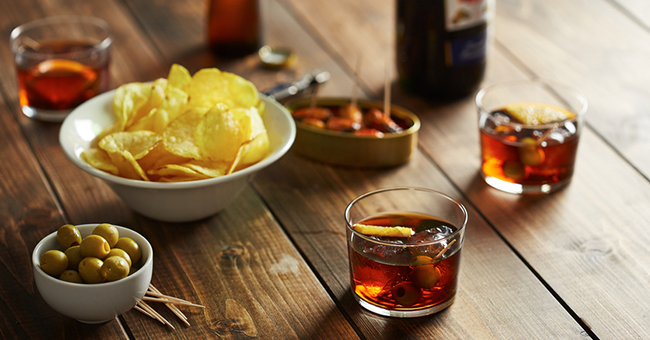While living in Barcelona a few years ago, I saw them everywhere: Chalkboard menus perched in front of bars from the Gothic Quarter to the Gracia screaming “Vermut, 2€!”
Never one to pass up a bargain, I started ordering vermut (the Catalan spelling of “vermouth”) every time I went out, curious about why the Spanish would make a starring player out of a spirit I always thought of as a mixer my grandma sloshed into her sticky-sweet Manhattans. The tawny-colored liquor was usually poured from a tap, and depending on the bar, would be served either up or on the rocks, with or without a squirt of soda, and garnished with a lemon twist, an orange slice, a green olive or nothing at all.
Though its modern origins are often pegged to Italy, wine fortified with herbs has been used medicinally in many cultures for thousands of years. In Catalunya’s Reus region, distillers like Yzaguirre have been blending fortified white wine with sugar, herbs and botanicals like pomelo, nutmeg, Roman chamomile and wormwood for more than a century, lending Spain a vermouth culture all its own.
In Barcelona, to “fer un vermut” (literally “to do a vermouth,” but broadly meaning “to go get a drink”), refers to more than just the drink itself: it’s a whole ritual marked with some specific do’s and don’ts. I learned this the embarrassing way when I ordered a round one Saturday night and caught the curmudgeonly barkeep trading a knowing glance with a guy at the end of the bar.
“What was that about?” I asked the guy, a regular who introduced himself as Jorge.
“It’s a guiri thing,” he explained, using Spanish pejorative slang meaning “foreigner.” “Vermouth is a thing you do on Sundays, after mass and before lunch.”
Jorge explained that herbaceous vermouth is meant to “open the appetite” before a big meal. While the Sunday tradition never really went away in certain pockets of Spain, in places like Barcelona, vermouth itself fell out of fashion as people started switching to beer and wine in the ’70s and ’80s. But it’s been making a comeback with millennials: a recent ad campaign in the nearby city of Tarragona featured a slick website plastered with photos of young guys with flippy hair and Warby Parker shades hanging out and drinking vermouth.
I got the sense that drinking vermouth on a Saturday night in Spain might be kind of like ordering a mimosa at a nightclub in the States — just a bit off. So the next morning, a Sunday, I took a stab at “doing vermouth” the local way (minus the trip to church). Around noon, a friend and I jumped on bike-share bikes and pedaled the broad leafy boulevards of the L’Eixample neighborhood to arrive at Morro Fi, a capacity-18 vermouth bar that opened several years ago in a storefront just large enough to park a Smart Car in. With a name that translates loosely as “refined taste,” the folks behind Morro Fi know how to “fer un vermut” in style.
The scene was very metropolitan-brunch chic, the sidewalk tables filled with stroller-toting 30-somethings basking in the thin sunlight, clinking glasses and noshing on seafood and various pickled things: smoked tuna, olives, caper berries, anchovies, sardines, sweet and spicy little red peppers stuffed with goat cheese, potato chips — sharp, salty flavors that nicely complement the herby-sweet vermouth.
The snacks that are traditionally served at vermouth time vary from region to region, explains François Monti, the Belgian-born, Madrid-based author of El Gran Libro del Vermut. Olives and potato chips are the most basic accompaniments, along with “any of the first-plate tapas: tortilla, croquetas, patatas bravas.” Some bars serve cured meats like jamón or chorizo with their vermouth, but Monti finds this blasphemous (“they work much better with sherry”).
Any bar considering adding a snacks program to complement its vermouth menu would be well advised to follow Monti’s advice: “The ideal pairing is with encurtidos (pickled items): Pickled olives, pepinillos (gherkins), guindas (cherries), salt anchovies, smoked salmon on toast, bacalao, mussels in escabeche — anything pickled, in vinegar or other conservation method.”
It’s no coincidence that vermouth made a comeback in Spain at the same time as the global economy started tanking. At around 15% ABV, vermouth offers the best bang for your euro. Morro Fi sells a one-liter to-go bottle for less than 7€ ($7.65).
When I came back to the States, I again watched as vermouth became the hottest new thing in bartending. But while Americans are finding a new appreciation for Europe’s favorite aperitivo, the surrounding social context typically hasn’t tagged along — and that’s unfortunate.
“[The best bars know that] ‘la hora del vermut’ is much more than just having a quick drink and nibbling on crisps,” Monti says. “It’s all about sharing an hour with family on Sunday before heading home for lunch. Of course, you need a good drink and some food, but above all you need to feel at home to wind down surrounded with good folks.”





